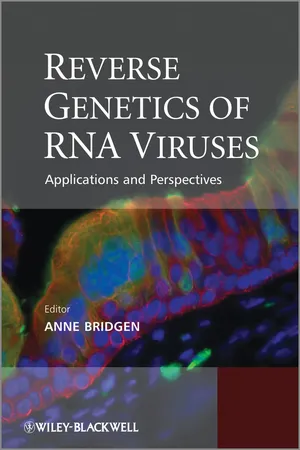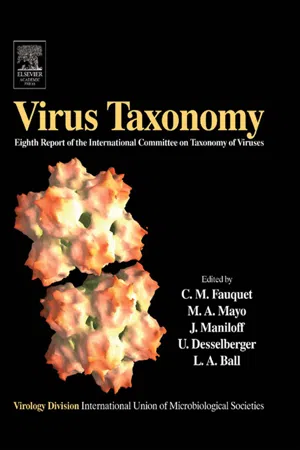Biological Sciences
Negative Sense RNA
Negative sense RNA is a single-stranded RNA molecule that is complementary to the mRNA and cannot be directly translated into proteins. It requires the synthesis of a complementary positive sense RNA strand before protein production can occur. Negative sense RNA is commonly found in viruses and serves as a template for the production of viral proteins.
Written by Perlego with AI-assistance
Related key terms
3 Key excerpts on "Negative Sense RNA"
- eBook - ePub
Reverse Genetics of RNA Viruses
Applications and Perspectives
- Anne Bridgen(Author)
- 2012(Publication Date)
- Wiley(Publisher)
cis -acting signals must be maintained in modified genomes.Early attempts to rescue Negative Sense RNA viruses relied on the reconstitution of viral RNP complexes. The first virus for which this approach was successfully used was the segmented virus influenza A (Luytjes et al ., 1989). RNA transcripts, generated in vitro and containing the authentic terminal sequences from an influenza A genome segment flanking the gene for chloramphenicol acetyl transferase (CAT), were encapsidated in vitro by purified influenza A virus N protein, and the viral polymerase proteins (PA, PB1 and PB2) to produce a synthetic RNP complex. After transfection of this RNP complex into influenza A virus-infected cells, the synthetic genome segment was successfully replicated and transcribed to generate CAT protein. Interestingly, this approach failed to rescue non-segmented, Negative Sense RNA viruses probably due to the tighter RNP complex structure in these viruses (Baudin et al ., 1994). The first successful demonstration of rescue of a foreign gene for MV involved the use of a negative-sensed minigenome; the MV 3' and 5' non-coding termini (NCT) consisting of the Le and Tr (containing the GP and AGP promoters) and the N 5' UTR and L 3' UTR (containing the N GS and the L GE signals), flanking the ORF for the CAT reporter gene (Sidhu et al ., 1995). These sequences were cloned into a plasmid designed to produce an in vitro minigenome RNA transcript of equivalent polarity to the genome but lacking all of the viral genes. The RNA was expressed using a T7 promoter (Plate 3A ). Generation of a precise 3' terminus is important for the subsequent replication of the minigenome inside cells. This was achieved by incorporating a hepatitis δ ribozyme sequence into the minigenome clone. The hepatitis δ ribozyme sequence is ideal for this purpose, in that only sequences downstream of the cleavage site are required for the autocatalytic activity (Perrotta and Been, 1991). Therefore upon in vitro transcription and ribozyme folding there is an autocatalytic, intramolecular cleavage event within the nascent RNA transcript producing RNA molecules with the exact 3' end of the virus minigenome (Rosenstein and Been, 1991). The difference between this and the influenza rescue described above was that the RNP complex was not formed outside of the cell. Instead the synthetic minigenomic RNA was transcribed in vitro - eBook - ePub
Translational Medicine
Molecular Pharmacology and Drug Discovery
- Robert A. Meyers(Author)
- 2018(Publication Date)
- Wiley-Blackwell(Publisher)
Besides the delivery issues discussed above, viral escape represents a significant challenge when targeting viral genomes with RNAi. Indeed, it has been shown that poliovirus readily escapes highly effective siRNAs through unique point mutations within the targeted regions, resulting in the emergence of resistant viruses [142]. Likewise, HIV was able to escape RNAi either directly, by mutations in the targeted region, or indirectly by mutations in promoter regions that compensated for the RNAi by upregulating viral transcription [195]. It is important to note that such a mechanism of viral escape is not confined to mammalian viruses but has been also observed in plants and mosquitoes with the turnip mosaic virus (TuMV) and Dengue virus (DENV2), respectively. This phenomenon is not surprising since viruses – especially RNA viruses – possess a high ability to mutate on the basis of their low-fidelity RdRP. A solution to this problem would be to use a combination of small RNAs targeting different regions of the genome, to increase efficacy and decrease the chances of escape (e.g., the targeting of SARS with two siRNAs [151] or Ebola virus with three siRNAs targeting different structural and nonstructural proteins [196]). Another option that has been used successfully in preclinical studies to prevent HIV-1 infection was to combine one siRNA targeting the virus and one siRNA targeting a host molecule, the viral coreceptor CCR5 [170]. Of note, the issue of viral escape can be addressed by targeting only a host molecule that is essential for the viral replication cycle. Such a strategy, based on inhibition of the hepatocellular microRNA miR122 by LNAs, offers a very promising perspective to treat HCV infections [150].6 Conclusions
The discovery of RNA silencing, a major finding of the late twentieth century, has opened new avenues of investigation in both applied and fundamental scientific research. Interestingly, the rationale design of antisense RNAs to inhibit viral replication predates the discovery of the role of RNA silencing in a natural context in the regulation of viral infection. As a result, initial attempts to inhibit viral replication by antisense oligonucleotides were mainly seen as ‘groping in the dark.’ On the business side, the initial striking results obtained with model organisms and tissue culture cells raised high hopes and led to a flurry of patents and new companies [155]. Unfortunately, however, unmet expectations in terms of delivery technologies, in addition to the potential of some silencing RNA formulations to trigger responses in a sequence-independent manner, through the activation of innate immunity, raised suspicion for investors and slowed down the development of the industry. - eBook - ePub
Virus Taxonomy
VIIIth Report of the International Committee on Taxonomy of Viruses
- Claude M. Fauquet, M.A. Mayo, J. Maniloff, U. Desselberger, L.A. Ball(Authors)
- 2005(Publication Date)
- Academic Press(Publisher)
Once the nucleocapsid (RNA, N, L, P) is released into the cytoplasm, the genome RNA is repetitively transcribed (primary transcription) by the virion transcriptase. N protein removal is not required since the transcriptase recognizes the RNA-N protein complex as template. The capped and polyadenylated mRNAs are generally translated in cytoplasmic polysomes except for the G mRNA which is translated on membrane-bound polysomes. Transcription occurs in the presence of protein synthesis inhibitors indicating that it does not depend on de novo host protein synthesis. Following translation, RNA replication occurs in the cytoplasm (full-length positive and then full-length negative RNA synthesis). Certain plant rhabdoviruses may replicate RNA in the cell nucleus. Replication again occurs on the RNA-N protein complex and requires the newly synthesized N, P and L protein species to concomitantly encapsidate the nascent RNA into a nucleocapsid structure. Apart from freshly translated N-P-L proteins, replication may require host factors. However, vesiculoviruses can replicate in enucleated cells, indicating that newly synthesized host gene products are not required. It has been proposed that the concomitant binding of N protein to the nascent positive or negative-sense viral RNA species may promote replication rather than transcription, by favoring read-through of transcription termination signals. Replication leads to the synthesis of a full length positive strand antigenome RNA. This, in turn, serves as a replicative intermediate for the synthesis of negative strand genome RNAs for the progeny virions. Following replication, further rounds of transcription (secondary transcription), translation and replication ensue. A very typical feature of negative strand RNA viruses (shared by all members of the order Mononegavirales) is that the RNA genome (or antigenome) is never “naked” in the cell but is always encapsidated by the nucleoprotein
Index pages curate the most relevant extracts from our library of academic textbooks. They’ve been created using an in-house natural language model (NLM), each adding context and meaning to key research topics.


